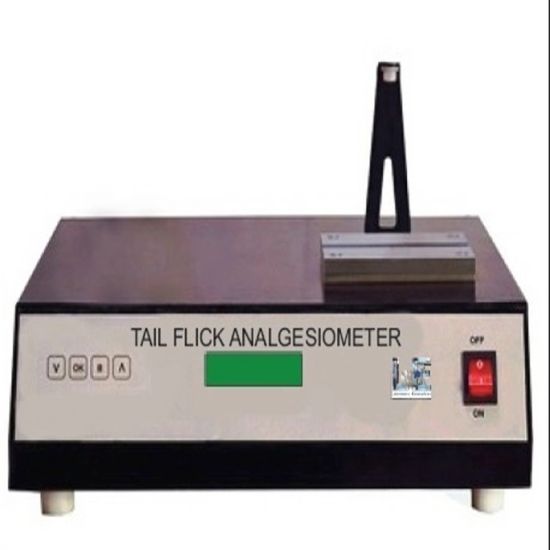
| |
Tail Flick Type Analgesiometer
TAIL FLICK TYPE ANALGESIOMETER
 The tail flick analgesimeter is a widely used instrument in pharmaceutical research for assessing the pain threshold and analgesic (pain-relieving) efficacy of drugs in rodents, typically rats and mice. Here's how it is used and its significance in research: Assessment of Pain Sensitivity: The tail flick test measures the pain sensitivity of rodents by applying a noxious thermal stimulus to the animal's tail and recording the latency to respond by flicking or withdrawing the tail. This response is a reflexive action to avoid the painful stimulus. Testing Analgesic Drugs: The primary use of the tail flick analgesimeter is to evaluate the efficacy of analgesic compounds. By comparing the response latency before and after drug administration, researchers can determine how effectively a drug increases the pain threshold. An effective analgesic will increase the latency to tail flick, indicating reduced pain perception. Dose-Response Studies: Researchers use the tail flick test to conduct dose-response studies, which involve administering different doses of an analgesic and measuring the corresponding changes in tail flick latency. This helps determine the optimal dose and potency of the drug. Mechanistic Studies: The tail flick test can be used to investigate the mechanisms of action of analgesic drugs. By using the test in combination with receptor agonists or antagonists, or genetic modifications, researchers can study the involvement of specific neurotransmitter systems (e.g., opioid, serotonin, GABA) in mediating the drug's analgesic effects. Comparative Studies: The tail flick analgesimeter allows for comparative studies of different analgesic agents or formulations. This is important for developing new pain relief medications and determining their relative efficacy compared to existing treatments. Chronic Pain Models: The tail flick test can be adapted for use in chronic pain models to evaluate the effectiveness of analgesic drugs over longer periods. This is useful for studying the potential of drugs to treat chronic pain conditions in humans. Behavioral Phenotyping: The tail flick test is part of a suite of behavioral assays used for phenotyping genetically modified rodents. It helps in understanding how genetic alterations affect pain sensitivity and analgesic responses. Validation of Pain Models: The tail flick test is used to validate animal models of pain. By demonstrating consistent pain responses and analgesic effects, researchers can establish the reliability of their models for studying pain and developing new treatments. Procedure Overview Preparation: The rodent is typically restrained gently to minimize movement without causing stress. Application of Stimulus: A focused beam of light or a heated element is applied to a specific part of the tail. Measurement: The time taken (latency) for the rodent to flick or withdraw its tail from the heat source is recorded. Data Analysis: The latency is compared across different conditions, such as before and after drug administration, to assess changes in pain sensitivity. Laboratory Enterprises is leading Manufacturer, Exporter & Supplier of Digital Plethysmometer, Digital Tablet Hardness Tester, Grip Strength Meter, Diffusion Cell Apparatus, Digital Organ Bath System, Analgesiometer (Hot and Cold Plate Type), Products / ServicesDigital Plethysmometer, Tablet Hardness Tester, Grip Strength Meter, Diffusion Cell Apparatus, Hot & Cold Plate Type Year of Establishement 2007 Nature of Business Manufacturers, Exporters Contact Person Mrs. ELVINA V. KUMAR Contact UsMILTON ENTERPRISESF-7, PRANAV HEIGHTS, OPPO. R. K. LAWNS,Nashik, Maharashtra, 422010, India Recently Added Products in Nashik, MaharashtraRecently Registered Companies in Nashik, Maharashtra |
Contact Us
MILTON ENTERPRISES
F-7, PRANAV HEIGHTS, OPPO. R. K. LAWNS,Nashik, Maharashtra 422010, India
Phone: 2532386081
Mobile: 9168129688
© Copyright 2024 MILTON ENTERPRISES, Nashik, India. All Rights Reserved